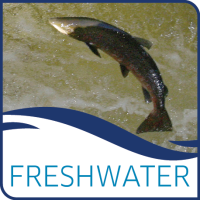The conservation status of 173 wild Atlantic salmon stocks (rivers or small groups of rivers) is assessed annually within Scotland according to how likely it is their numbers are at sustainable levels as part of the Salmon Conservation Regulations process (https://www.gov.scot/policies/salmon-and-recreational-fisheries/conserva...). Most stocks are in poor conservation status (less than 60% chance of meeting their conservation limit) and these are spread throughout the country. Stocks in good conservation status (at least 80% chance of meeting their conservation limit) tend to be located in east Scotland and contain the majority of the total number of salmon estimated to be in Scottish rivers.
Since 2017, the total number of stocks in good status has declined while the number in poor status has increased. Additionally, many individual stocks in good conservation status have experienced significant declines in the number of returning salmon, highlighting the need for precautionary management.
Since the 1970s, the total estimated number of salmon returning to Scottish rivers has declined from around 1 million to 400,000. Over the same period the number of spawners increased from around 380,000 in the early 1970s to a high point of 670,000 in 2010 before declining to around 350,000 in recent years.
Data and Resources
- Adult salmon stock Statuscsv
Table of measures and number of stocks by status. The following columns are...
Preview Download - Adult Salmon stock abundancecsv
This dataset contain the following columns:
Return year:...
Preview Download - Topic Sheet: The status of salmon in Scotland: 2025html
An overview of the status of wild Atlantic salmon stocks in Scotland up to...
Go to resource
| Field | Value |
|---|---|
| Publisher | |
| Modified | 2025-08-01 |
| Release Date | 2024-07-26 |
| Identifier | 355e38fa-1082-4862-a3a4-69486c5777cf |
| Spatial / Geographical Coverage Area | POLYGON ((-8.876953125 54.036005911199, -8.876953125 61.124008781291, -0.17578125 61.124008781291, -0.17578125 54.036005911199)) |
| Temporal Coverage | 1971-01-01 to 2025-12-31 |
| Language | English (United Kingdom) |
| License | UK Open Government Licence (OGL) |
| Data Dictionary | Stocks in assessable areas are managed according to their conservation status. Assessment is undertaken at the scale of the river, or on groups of smaller neighbouring rivers where rod fishery data is not available by river. In addition, stocks associated with Special Areas of Conservation (SACs), designated under the EU Habitat’s Directive due to their importance for Atlantic salmon, are assessed separately. Each stock is assessed by setting an egg requirement (conservation limit; CL) and estimating whether or not this requirement is met. Stocks with at least 80% probability of meeting their CL are classed as in 'good' conservation status; stocks with between 60%-80% probability of meeting their CL are classed as in 'moderate' conservation status and stocks with less than 60% probability of meeting their CL are classed as in 'poor' conservation status. Numbers of eggs are used as the basis for assessment to account for temporal and geographic changes in biological characteristics such as size and age of the individuals or the sex ratio of the stock. Assessments are carried out annually, based on the stock abundance data (rod catch and fish counts where available) for the previous 5 years. Conservation status for a given year determines the management measures for that area in the following year (details can be found online at https://www.gov.scot/policies/salmon-and-recreational-fisheries/conserva...). Data for these assessments were available from 2011. The first year for which angling management measures are available is therefore 2017 (based on average attainment 2011 - 2015). The stock status associated with each angling season has been determined using the latest data and methods and therefore may differ from the Regulations in force during each angling season. Trends in the estimated number of spawners within each stock was assessed by applying a Mann-Kendall test to detect a monotonic downwards trend in the median estimates of annual spawners from 2011-onward. The significance level was set at p = 0.1. Estimates of returns to the coast and spawners for all of Scotland were derived from stock abundance data (rod catch and fish counts where available) together with information on fishing and natural in-river mortality. Numbers are medians estimated from the modelling process. |
| Contact Name | Marine Directorate, Scottish Government |
| Contact Email | |
| Public Access Level | Public |


